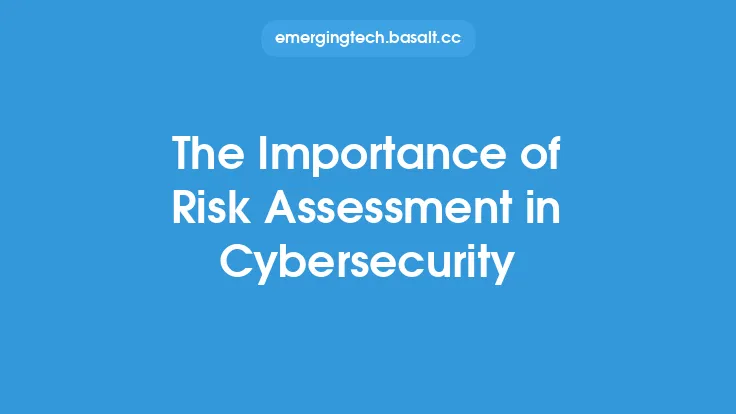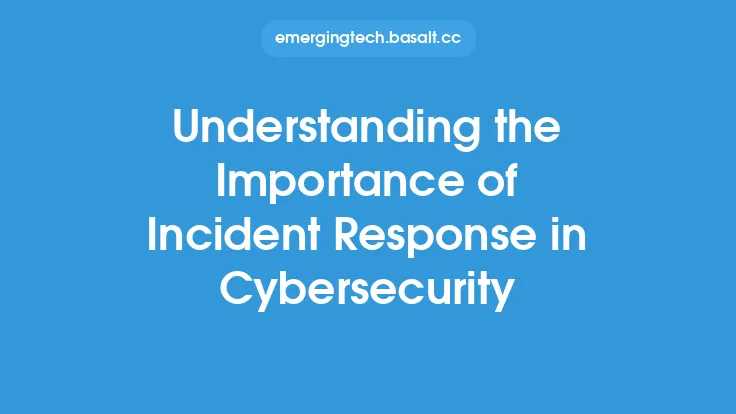As the world becomes increasingly reliant on emerging technologies such as artificial intelligence, blockchain, and the Internet of Things (IoT), the risk of cyber attacks and data breaches has grown exponentially. Managing cybersecurity risk in this new landscape requires a comprehensive and proactive approach that takes into account the unique challenges and vulnerabilities of these emerging technologies. In this article, we will explore the key considerations and best practices for managing cybersecurity risk in the age of emerging technologies.
Introduction to Emerging Technologies and Cybersecurity Risk
Emerging technologies such as AI, blockchain, and IoT have the potential to revolutionize the way we live and work, but they also introduce new cybersecurity risks that must be addressed. For example, AI systems can be vulnerable to attacks that manipulate their decision-making processes, while blockchain systems can be susceptible to attacks that exploit their decentralized nature. IoT devices, meanwhile, can be vulnerable to attacks that compromise their security and privacy. To manage these risks, organizations must have a deep understanding of the cybersecurity threats and vulnerabilities associated with emerging technologies.
Assessing Cybersecurity Risk in Emerging Technologies
Assessing cybersecurity risk in emerging technologies requires a thorough understanding of the technology itself, as well as the potential threats and vulnerabilities that it may be exposed to. This includes identifying potential attack vectors, such as network interfaces, software vulnerabilities, and human factors. It also requires an understanding of the potential consequences of a cyber attack, including data breaches, system downtime, and reputational damage. Organizations can use risk assessment frameworks such as NIST Cybersecurity Framework or ISO 27001 to identify and prioritize cybersecurity risks associated with emerging technologies.
Implementing Cybersecurity Controls for Emerging Technologies
Implementing cybersecurity controls for emerging technologies requires a layered approach that includes multiple controls and countermeasures. This may include technical controls such as firewalls, intrusion detection systems, and encryption, as well as non-technical controls such as policies, procedures, and training. For example, organizations may implement controls to restrict access to AI systems, or to monitor and detect anomalies in blockchain transactions. They may also implement controls to secure IoT devices, such as encryption and secure authentication protocols.
Managing Third-Party Cybersecurity Risk in Emerging Technologies
Many organizations rely on third-party vendors and suppliers to provide emerging technologies such as AI, blockchain, and IoT. However, this can introduce new cybersecurity risks, as third-party vendors may have different security controls and protocols in place. To manage these risks, organizations must have a thorough understanding of their third-party vendors' cybersecurity practices and protocols. This includes conducting regular risk assessments and audits, as well as implementing contracts and agreements that require third-party vendors to adhere to certain cybersecurity standards and practices.
Incident Response and Cybersecurity Risk Management
Despite the best efforts to prevent cyber attacks, incidents can still occur. To manage cybersecurity risk in emerging technologies, organizations must have an incident response plan in place that includes procedures for responding to and containing cyber attacks. This includes identifying the incident, containing the damage, and restoring systems and data. Organizations must also have a plan in place for communicating with stakeholders, including customers, employees, and regulators. This includes providing timely and transparent information about the incident, as well as any steps that are being taken to prevent similar incidents in the future.
Continuous Monitoring and Cybersecurity Risk Management
Continuous monitoring is a critical component of managing cybersecurity risk in emerging technologies. This includes regularly reviewing and updating cybersecurity controls and protocols, as well as monitoring for potential threats and vulnerabilities. Organizations can use tools such as security information and event management (SIEM) systems to monitor and analyze security-related data, and to identify potential security incidents. They can also use vulnerability scanning and penetration testing to identify potential vulnerabilities and weaknesses in their systems and applications.
Cybersecurity Awareness and Training
Cybersecurity awareness and training are critical components of managing cybersecurity risk in emerging technologies. This includes providing employees with regular training and awareness programs, as well as ensuring that they understand the potential cybersecurity risks and threats associated with emerging technologies. Organizations can use a variety of training methods, including online courses, workshops, and simulations, to educate employees about cybersecurity best practices and protocols. They can also use phishing simulations and other types of training exercises to test employees' knowledge and awareness of cybersecurity threats and risks.
Cybersecurity Governance and Compliance
Cybersecurity governance and compliance are critical components of managing cybersecurity risk in emerging technologies. This includes ensuring that organizations have a clear and well-defined cybersecurity governance structure, as well as policies and procedures that are aligned with regulatory requirements and industry standards. Organizations must also ensure that they are complying with relevant laws and regulations, such as the General Data Protection Regulation (GDPR) and the Payment Card Industry Data Security Standard (PCI DSS). This includes regularly reviewing and updating cybersecurity policies and procedures, as well as conducting regular audits and risk assessments to ensure compliance with regulatory requirements.
Conclusion
Managing cybersecurity risk in the age of emerging technologies requires a comprehensive and proactive approach that takes into account the unique challenges and vulnerabilities of these technologies. This includes assessing cybersecurity risk, implementing cybersecurity controls, managing third-party risk, responding to incidents, continuously monitoring for threats and vulnerabilities, providing cybersecurity awareness and training, and ensuring cybersecurity governance and compliance. By following these best practices, organizations can help to protect themselves against cyber attacks and data breaches, and ensure the confidentiality, integrity, and availability of their systems and data.





